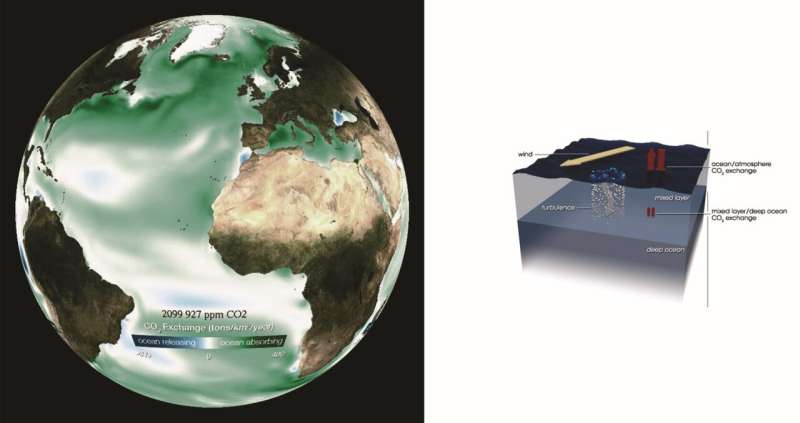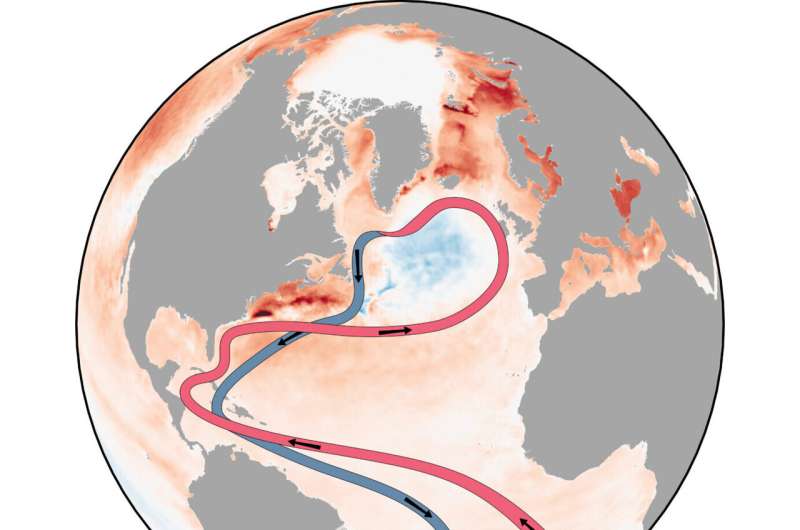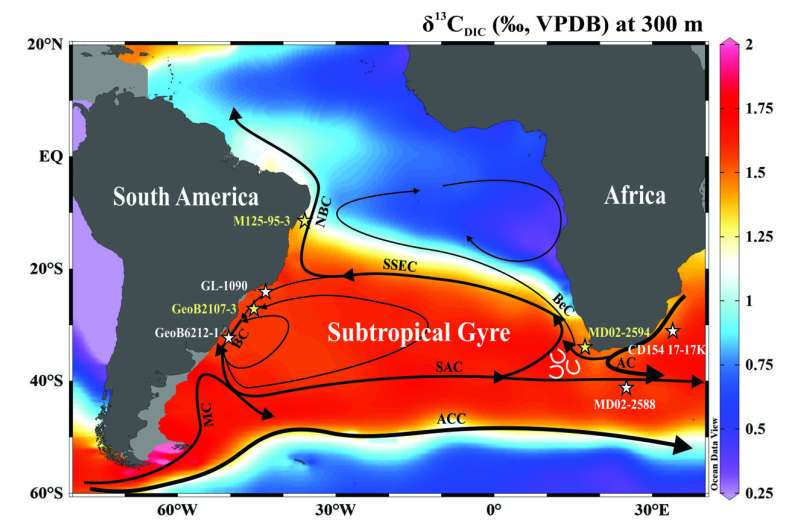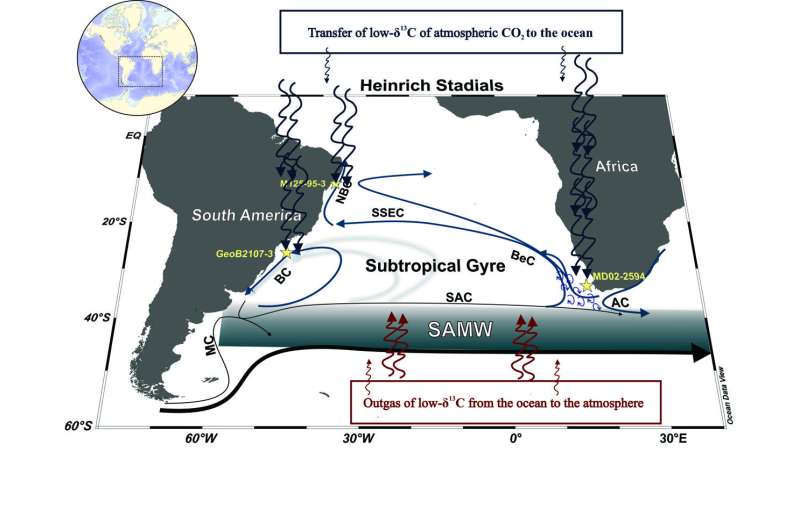September 12, 2023 dialog
This article has been reviewed according to Science X's editorial process and policies. Editors have highlighted the following attributes while ensuring the content's credibility:
fact-checked
peer-reviewed publication
trusted source
written by researcher(s)
proofread
Unveiling ancient climate secrets: South Atlantic's role in carbon exchange

In the annals of Earth's history, I've stumbled upon a gripping narrative of climate fluctuations and the captivating exchange of carbon. Recent research, which made headlines in the scientific journal Global and Planetary Change, transports us back to the last Ice Age—a time when the Earth sported vastly different atmospheric CO2 levels and global temperatures.
This investigation, delving into minuscule microshells nestled within marine sediments, unravels the intricate relationship between our planet's atmosphere and the enigmatic South Atlantic. Join me on this intriguing voyage as we dive into how this discovery is improving our comprehension of Earth's climate system.
The last Ice Age and the Heinrich Stadials
Picture an era when our planet underwent swift and dramatic climate transformations, spanning geological epochs. These climatic upheavals bear the name Heinrich Stadials (HS), an homage to paleoceanographer Hartmut Heinrich. These events were marked by the weakening of the Atlantic Meridional Overturning Circulation (AMOC) and the liberation of colossal icebergs into the North Atlantic.
This slowdown in the AMOC led to heat accumulation in the South Atlantic and a chill in the North Atlantic. Astonishingly, during these HS episodes, atmospheric CO2 levels swelled. The probable perpetrator? The natural release of oceanic CO2 through a phenomenon known as upwelling in the Southern Ocean, adjacent to Antarctica.
Stable carbon isotopes: Clues from a past era
Venturing into the realm of stable carbon isotopes within ancient atmospheric CO2, scientists stumbled upon a trove of knowledge. They discovered a preponderance of the lighter carbon isotope 12C. This particular 12C had been entombed in the ocean's depths for eons, yet something was orchestrating its return to the atmosphere, contributing to the burgeoning CO2 levels.

To demystify this enigma, researchers set their sights on planktonic foraminifera. These minuscule marine creatures, adorned with calcareous microshells, held the key to deciphering ocean temperatures. In essence, these tiny beings acted as an oceanic "thermometer" by revealing crucial ratios of magnesium (Mg) to calcium (Ca) within their shells. Their findings pointed to a warming South Atlantic during HS events, harmonizing with the enfeebled AMOC. Notably, contemporary observations have indicated a recent weakening of the AMOC.
Carbon isotopes in planktonic foraminifera: The plot thickens
The intrigue didn't end there. Carbon isotope analyses of planktonic foraminifera residing in the South Atlantic's subsurface, roughly 300 meters below the ocean's surface, uncovered parallels with atmospheric changes during HS events. More 12C relative to 13C was uncovered, painting a compelling picture. Nevertheless, these isotopic values differed between the microshells and the surrounding ocean (dissolved inorganic carbon), due to the varied biological activities of foraminifera.

In the quest to ascertain equilibrium between the carbon isotope values in foraminifera shells and the waters of the South Atlantic, researchers undertook intricate calculations to predict carbon isotope values in seawater. These calculations considered surface temperatures at three distinct study sites and global carbon isotope values during millennia-old HS events. Astonishingly, the results unveiled a state of equilibrium between measured carbon isotope values and their predicted counterparts in the South Atlantic.
Put simply, these diminutive microshells hold invaluable insights into the transfer of carbon between the ocean and the atmosphere. Furthermore, the study illuminated that this exchange spanned not only during abrupt events, but extended to the deeper layers of the South Atlantic on a longer timescale.
The South Atlantic's role as a carbon reservoir
This trailblazing research hints at the South Atlantic serving as a plausible carbon reservoir during the last Ice Age, profoundly influencing Earth's carbon equilibrium between the ocean and the atmosphere. These revelations offer powerful tools for climate models, helping us gauge the ocean's capacity to absorb the mounting levels of atmospheric CO2 anticipated in the near future.

As the transfer of carbon from the atmosphere to the ocean intensifies, its repercussions may ripple through marine ecosystems, influencing a spectrum of species—from fish to plankton and coral reefs. Grasping these transformations holds paramount importance, particularly for coastal communities whose lives are intricately entwined with these ecosystems.
In conclusion, the saga of the South Atlantic's role in carbon exchange paints a vivid portrait of our planet's dynamic past. These age-old enigmas provide invaluable insights to navigate the challenges posed by our evolving climate. Our expedition continues, guided by scientists endeavoring to unravel the intricate tapestry of interactions that shape our planet's climate system.
This story is part of Science X Dialog, where researchers can report findings from their published research articles. Visit this page for information about ScienceX Dialog and how to participate.
More information: Tainã M.L. Pinho et al, Thermodynamic air-sea equilibration controls carbon isotopic composition of the South Atlantic thermocline during the last glacial period, Global and Planetary Change (2023). DOI: 10.1016/j.gloplacha.2023.104223
Journal information: Global and Planetary Change , Global Biogeochemical Cycles
Tainã Pinho holds an MSc. in marine geology, specializing in paleoceanography and paleoclimate, which Pinho has been working on since 2016. Pinho completed a master's at the University of São Paulo (USP) in Brazil and is currently pursuing a PhD at the Alfred Wegener Institute (AWI). Pinho's research journey is dedicated to unraveling Earth's ancient oceans and climates, aiming to shed light on the forces that have shaped our planet's history.




















